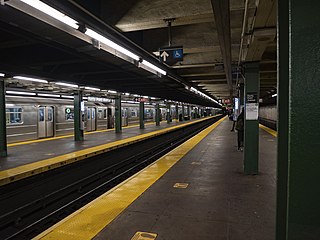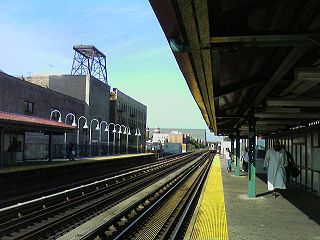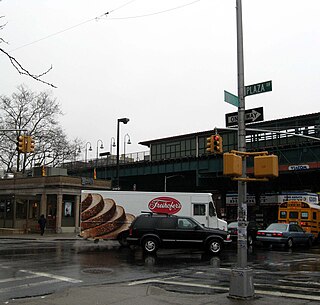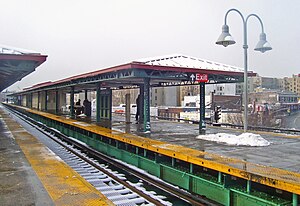
The 103rd Street station is a local station on the IRT Lexington Avenue Line of the New York City Subway. Located at the intersection of Lexington Avenue and 103rd Street in East Harlem, it is served by the 6 train at all times, the <6> train during weekdays in the peak direction, and the 4 train during late nights.

The Hunts Point Avenue station is an express station on the IRT Pelham Line of the New York City Subway, served by the 6 train at all times and the <6> train on weekdays in the peak direction. It is located at Hunts Point Avenue and Southern Boulevard in the Longwood neighborhood in the Bronx.

The Whitlock Avenue station is a local station on the IRT Pelham Line of the New York City Subway. It is served by the 6 train at all times and is located at Whitlock Avenue and Westchester Avenue in the Foxhurst neighborhood of the Bronx.

The St. Lawrence Avenue station is a local station on the IRT Pelham Line of the New York City Subway. The station, served by the 6 train at all times, is located at the intersection of St. Lawrence Avenue and Westchester Avenue in the Parkchester neighborhood of the Bronx.

The Pelham Bay Park station is the northern terminal station of the IRT Pelham Line of the New York City Subway. Located across from Pelham Bay Park, at the intersection of the Bruckner Expressway and Westchester Avenue in the Pelham Bay neighborhood of the Bronx, it is served by the 6 train at all times, except weekdays in the peak direction, when the <6> serves it.

The Woodlawn station is the northern terminal of the New York City Subway's IRT Jerome Avenue Line. The station is located at the intersection of Bainbridge and Jerome Avenues, outside Woodlawn Cemetery. Despite the station name, this intersection is in the Norwood neighborhood of the Bronx, and not in Woodlawn. It is served by the 4 train at all times. This station was constructed by the Interborough Rapid Transit Company as part of the Dual Contracts and opened in 1918.

The Mosholu Parkway station is a local station on the IRT Jerome Avenue Line of the New York City Subway. Located at the intersection of Mosholu Parkway and Jerome Avenue in the Bedford Park and Norwood neighborhoods of the Bronx, it is served by the 4 train at all times.

The Bedford Park Boulevard–Lehman College station is a local station on the IRT Jerome Avenue Line of the New York City Subway. Located at the intersection of Bedford Park Boulevard immediately west of Jerome Avenue in the Bedford Park neighborhood of the Bronx, it is served by the 4 train at all times. It is also the only station on the Jerome Avenue Line north of 170th Street that is not located above Jerome Avenue. This station was constructed by the Interborough Rapid Transit Company as part of the Dual Contracts and opened in 1918.

The Kingsbridge Road station is a local station on the elevated IRT Jerome Avenue Line of the New York City Subway. Located at the intersection of Kingsbridge Road and Jerome Avenue in the Kingsbridge Heights neighborhood of the Bronx, it is served by the 4 train at all times. This station was constructed by the Interborough Rapid Transit Company as part of the Dual Contracts and opened in 1917.

The Fordham Road station is a local station on the IRT Jerome Avenue Line of the New York City Subway. Located at the intersection of Fordham Road and Jerome Avenue in the University Heights and Fordham Heights neighborhoods of the Bronx, it is served by the 4 train at all times. This station was constructed by the Interborough Rapid Transit Company as part of the Dual Contracts and opened in 1917.

The 183rd Street station is a local station on the elevated IRT Jerome Avenue Line of the New York City Subway. Located at the intersection of 183rd Street and Jerome Avenue in the Univeristy Heights and Fordham Heights neighborhoods of the Bronx, it is served by the 4 train at all times. This station was constructed by the Interborough Rapid Transit Company as part of the Dual Contracts and opened in 1917.

The 176th Street station is a local station on the IRT Jerome Avenue Line of the New York City Subway. Located at the intersection of 176th Street and Jerome Avenue in the Morris Heights neighborhood of the Bronx, it is served by the 4 train at all times. This station was constructed by the Interborough Rapid Transit Company as part of the Dual Contracts and opened in 1917.

The Mount Eden Avenue station is a local station on the IRT Jerome Avenue Line of the New York City Subway. Located at the intersection of Mount Eden and Jerome Avenues in the Highbridge neighborhood of the Bronx, it is served by the 4 train at all times. This station was constructed by the Interborough Rapid Transit Company as part of the Dual Contracts and opened in 1917.

The 170th Street station is a local station on the IRT Jerome Avenue Line of the New York City Subway. Located at the intersection of 170th Street and Jerome Avenue in the Highbridge neighborhood of the Bronx, it is served by the 4 train at all times. This station was constructed by the Interborough Rapid Transit Company as part of the Dual Contracts and opened in 1917.

The 167th Street station is a local station on the IRT Jerome Avenue Line of the New York City Subway. Located at the intersection of 167th Street and River Avenue in the Concourse neighborhood of the Bronx, it is served by the 4 train at all times. This station was constructed by the Interborough Rapid Transit Company as part of the Dual Contracts and opened in 1917.

The 61st Street–Woodside station is an express station on the IRT Flushing Line of the New York City Subway located at 61st Street and Roosevelt Avenue in Woodside, Queens. It is served by the 7 train, with additional peak-direction <7> service during rush hours.

The Third Avenue–138th Street station is an express station on the IRT Pelham Line of the New York City Subway located at the intersection of Third Avenue and East 138th Street in the Bronx. It is served by the 6 train at all times and the <6> train during weekdays in the peak direction.

The 149th Street–Grand Concourse station is a New York City Subway station complex shared by the IRT Jerome Avenue Line and the IRT White Plains Road Line. It is located at East 149th Street and Grand Concourse in Mott Haven, Melrose and Concourse in the Bronx. The complex is served by the 2 and 4 trains at all times, and by the 5 train at all times except late nights.
The IRT Jerome Avenue Line, also unofficially known as IRT Woodlawn Line, is an A Division New York City Subway line mostly along Jerome Avenue in the Bronx. Originally an Interborough Rapid Transit Company-operated route, it was built as part of the Dual Contracts expansion and opened in 1917 and 1918. It is both elevated and underground, with 161st Street–Yankee Stadium being the southernmost elevated station. The line has three tracks from south of the Woodlawn station to the 138th Street–Grand Concourse station. The Woodlawn Line also has a connection to the Jerome Yard, where 4 trains are stored, just north of the Bedford Park Boulevard–Lehman College station.

The 161st Street–Yankee Stadium station is a New York City Subway station complex shared by the elevated IRT Jerome Avenue Line and the underground IND Concourse Line. It is located at the intersection of 161st Street and River Avenue in the Highbridge and Concourse neighborhoods of the Bronx. It is generally served by the 4 train at all times; the D train at all times except rush hours in the peak direction ; and the B train during rush hours.

























